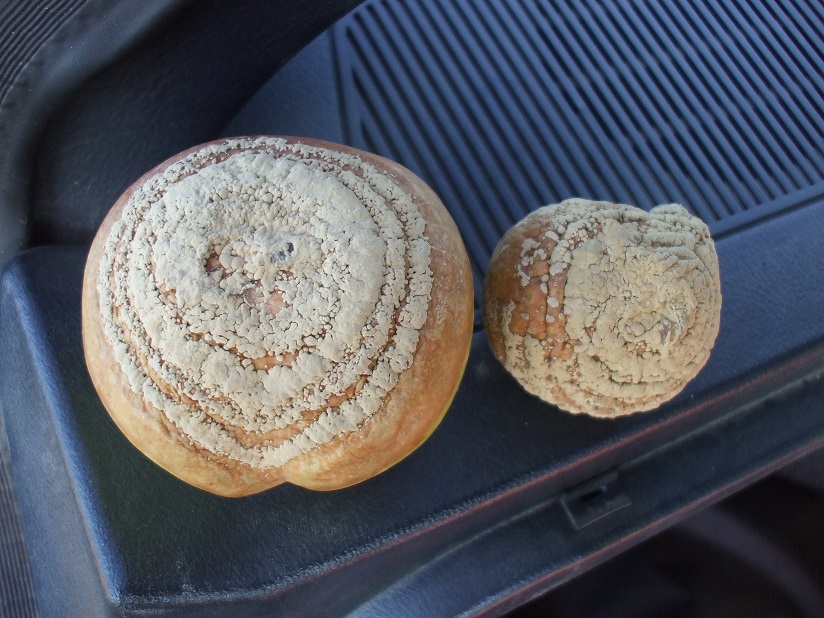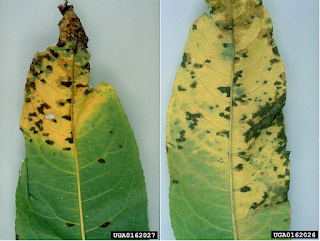Three Main Peach Diseases and How to Approach Their Management – Brown Rot, Rusty Spot and Bacterial Spot
(I) BROWN ROT (Monilinia species). In many locations with wet springs, brown rot is key driver of your stone fruit spray program. Fruit protection using alternation of fungicides with different modes of action is essential to avoid fungicide resistance and have good quality fruit at harvest free of brown rot. The key period when peach fruit are susceptible to diseases, and to deliver the most effective fungicides, is from Petal Fall to Pit Hardening. Fungicide spray gaps in protection during this time will allow for latent infections that will be revealed much later when fruit get closer to ripening. The blossom blight stage of this disease is not a problem in Virginia and will not be addressed in this post, but in case you are a grower outside of Virginia, you can read these blog posts of mine covering this specific disease stage: Starting Stone Fruit Spray Program 2022 and Main Considerations and Stone Fruit Disease Management Considerations in the Extremely Early Tree Growth Start of 2023.
As the status of fungicide resistance in Monilinia spp. in Virginia is unknown (no one so far reported fungicide efficacy failures), during mid-summer and getting closer to pre-harvest period, you should tank mix single-site fungicides with other fungicides like Topsin M, captan or sulfur, and alternate standalone AP fungicides (Scala), with strobilurins (Gem, Pristine), FRAC group 17 fungicides (Elevate), SDHI-s (Fontelis), DMI-s (Rally, Indar, Tilt) or premixes (Pristine, Merivon), to maximize the yearly number of allowed applications per year of these fungicides, but not exceed them (e.g. Tilt should not be used more than 2 times in preharvest period). This will help avoid resistance development in the brown rot fungi. Gem, Inspire Super, Indar and Topsin M plus captan or sulfur will also control peach scab well but not Rally. Always read the label to determine all limitations in use of these fungicides.
In some parts of Virginia, brown rot fungus was found to be resistant to the benzimidazole fungicide Topsin M. Thus use Topsin M in combination with other (non-benzimidazole) fungicides. If you experience failure in control there might be fungicide resistance issue and these events of loss in efficacy express in times of high infection pressure fueled by excessive rains and cold weather. If efficacy failures occur, change tactics to apply the highest rates on the fungicide label to achieve complete Monilinia population kill and secure good canopy coverage (spraying on days with winds 8 mph or more is not going to secure good coverage). In such orchards, do not use alternate-row spraying.

RIMpro online cluster of models developed in Europe has brown rot prediction model which can help you decide when to apply your fungicides (Fig. 1). You can find out more information on subscription on:
https://rimpro.cloud/platform/brown-rot-monilinia-spp/
Subscription for one individual grower is $270 – 300 (EUR250) and allows you access to all the apple, stone fruit, and grape disease models but it also includes some insect pest occurrence prediction models (please contact me at acimovic@vt.edu and I can guide you through this process). So far we have eight NEWA stations connected to RIMpro.

Figure 1. Output from Brown Rot prediction model by RIMpro. Weather conditions frequently allow for infection (lower graph), but the real infection risk strongly depends on the inoculum, growth stage (flowering, ripening fruits), and wounding (e.g. hail, insects). Growth stages of many varieties of cherries, plums, nectarines apricots varies, and thus their susceptibility in time also varies. The user must set the estimated local date for flowering and harvest to allow the model to produce accurate predictions. The situation for ‘early’, ‘mid-season’ and ‘late’ varieties (left top corner of the Figure 1 above) is calculated and presented in parallel on the model output. In the example shown the early stone fruit varieties in this orchard are hit by severe infections during bloom resulting in brown rot blossom blight. The following infection events during April and May did not result in infected fruit as the fruit are not yet susceptible (April 5 – June 10). During June, when the fruit are maturing and susceptibility increases, a series of severe infections occurred just before and during harvest. These infections will result in an increase of latent infections that will manifest in the grocery store (Source: RIMpro B.V., France).
(II). RUSTY SPOT OF PEACH. This disease is usually rare disease in most orchards, but in dry summers can occur as a significant issue. This is a fungal disease developing on peach fruit only, thus leading to losses and it is caused the same pathogen causing apple powdery mildew – Podosphaera leucotricha. Disease is visible as smooth, bronzed, or russeted lesions on immature peach fruit. The fungus either overwinters in peach buds, or trees get infected from nearby apple trees as the source of infection (conidia i.e. spores of the fungus are spread to peaches by wind, dew and rain droplets). Critical timing for application of fungicides is from Shuck Split through 3rd cover (Pit Hardening). In other words young peach fruit are susceptible and get infected if protection is not timely applied. However, the infections can start as early as Petal Fall, and this is advised in case you had rusty spot on fruit lasst year (recent history of problems with this disease). If you are scouting your orchard frequently, finding the first white or rusty patch spot of this disease should be the trigger for an immediate fungicide application. The most effective fungicides are Gem, Luna Sensation, Merivon, Fontelis, Tilt, Elite, Inspire Super, Rally, Indar but keep in mind that Rally will not give good control of scab on peaches. Sulfur has good efficacy but requires more frequent application than the single site fungicides. Combinations of Topsin and sulfur or Topsin and Captan have fair to good efficacy. When using single-site fungicides do not apply more than four application per year of fungicides belonging to the same FRAC group (number you see on the pesticide label in the top right corner) and strive to alternate fungicides from other groups i.e. with other modes of action every week or a fortnight. This will reduce chances for development of fungicide resistance in P. leucotricha fungus to any of the groups individually, which if present would be a problem in both apple and peaches. Additionally, do not exceed the total number of sequential applications listed on the label (e.g. Group 7 fungicides aka SDHI-s) or their total number per season. Most cultivars are resistant to this disease but few examples like Rio-Oso-Gem and Redskin are highly susceptible. If you have a history of this disease in your orchard make sure to upgrade your spray program next year by starting a growth stage earlier with applying effective fungicides than what you used to do before (at least start from Petal Fall).
(III) BACTERIAL SPOT OF PEACH. Symptoms of bacterial spot of peach an be visible on leaves (Fig. 2) and rarely of fruit (Fig. 3). The difficulty is discerning the symptoms of copper leaf injury on leaves from bacterial leaf spot on leaves. Luckily, here is a short article by Dr. Kari Peter at Penn State University explaining the differences: https://extension.psu.edu/stone-fruit-disease-bacterial-spot Typical symptoms on leaves, which usually express before symptoms on fruit which are shown in Figure 3.
Figure 3. Early growing season bacterial spot infections on peach fruit visible as deep pits or cracks (Photo by Miller P. C. 2021)
The bacterial pathogen Xanthomonas arboricola pv. pruni causing peach spot of leaves and fruit overwinters in dark, gummy branch tips and twig cankers which develop from fall infections through leaf scars (copper products applied at leaf drop in fall will protect the leaf abscission scars from infections and will help with leaf-curl control; pruning removal of cankered or dark twigs during spring pruning can help reduce infection sources). Cankers develop in size the following spring releasing bacterial cells in the form of ooze droplets and are spread by rain and aerosol to young leaves, fruit and shoots. Spring with frequent rainfall with moderate temperatures and winds will favor the leaf and fruit infections. Symptoms on leaves are usually seen after bloom but infections occurred weeks ago. Protection of leaves is necessary as the high amount of leaf infections will lead to more fruit infections. If warm and wet conditions continue, longer infections after pit hardening are possible. Fruit infections take place after Shuck Split until Pit Hardening and require protection by alternating sprays of antibiotic oxytetracycline (FireLine, Mycoshield), Syllit plus captan, and low rate copper (however, copper can injure leaves and fruit under slow drying conditions). Keep in mind that oxytetracycline needs to be applied repeatedly when rainy and is mostly providing good control to merely suppressing the disease. However, oxytetracycline is the material least prone to causing phytotoxicity on peach and nectarines. Poor timing in delivery of this antibiotic and it’s overuse can lead to loss of it’s efficacy due to bacterial resistance. There is some evidence that the hydrochloride form of oxytetracycline (FireLine) is more effective than the calcium form Mycoshield. Do not apply either FireLine or Mycoshield on peaches or nectarines during 21 days before harvest. Syllit plus captan mixture is moderately effective and can cause phytotoxicity if no rain occurs between applications (do not add foliar nutrients or surfactants when applying Syllit plus captan). In wet conditions, sites with strong winds and sandy soils allow bacteria to spread better and then enter the leaves and fruit because the sand particles hitting them create abrasions and nicks, a perfect entry points for this pathogen. The best control of bacterial spot is planting resistant cultivars (e.g. Biscoe, Blazing Star, Candor, Contender, Harrow Beauty, Harrow Diamond, PF1, PF12A, PF24-007, PF27A, Starfire; source: Shane B. 2011). Many other cultivars have fair, moderate to good resistance to this disease, but can get infected severely if weather/site conditions favor this disease and chemical means of protection are not applied on time or as frequently as rain periods dictate.


